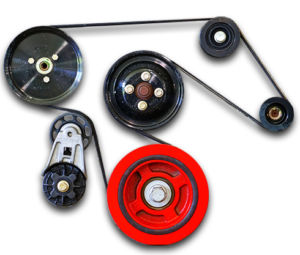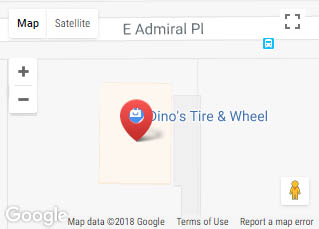Belt Tips
 Get your Timing Belt and Accessory Drive Belt professionally checked every 25,000 miles to make sure they are in working order.
Get your Timing Belt and Accessory Drive Belt professionally checked every 25,000 miles to make sure they are in working order.
Although the auto makers don’t usually specify a replacement interval for V-belts or serpentine (flat, multi-ribbed) belts, most belt manufacturers do recommend periodic replacement for preventative maintenance. Here’s why: the incidence of belt failure rises sharply in the fourth year of service for the typical V-belt, and the fifth year for serpentine belts.
What’s more, eight out of ten V-belt failures and ten out of ten serpentine belt failures end up causing a breakdown! That’s because belts have the uncanny knack of always picking the worst possible moment to fail — like when you’re heading out of town on that long-awaited fishing trip, when you’re hurrying to pick up a hot date who told you NOT to be late, or when you’re giving your dear mother-in-law a ride to church.
A broken belt is always bad news because when it snaps, all drive power to whatever it turns is lost. That means the water pump quits circulating coolant through the engine, the alternator quits producing amps, the power steering pump ceases to assist steering, and the air conditioner quits cooling. Many newer vehicles have a single serpentine belt that drives all of the engine’s accessories, so when it fails everything stops working.
The good news is that replacing the belts periodically can go a long way towards minimizing the risk of a breakdown caused by belt failure. After all, it’s a lot easier to replace a belt at your convenience than having the belt fail unexpectedly Heavens knows where.
For optimum protection, most experts recommend replacing V-belts every three to four years, or every 36,000 to 48,000 miles. A recommended replacement interval for serpentine belts would be every four or five years, or 50,000 miles.
Belt Life
The service life of a V-belt depends on mileage as well as load, tension and heat. Every time a belt passes around a pulley, it bends and flexes. This produces heat which age hardens the rubber over time. The wear process can be greatly accelerated if the belt is loose and slips because any added friction between belt and pulley makes the belt run even hotter. This can cause glazing on the faces of the belt and cause it to slip even more. So one of the most important factors that affects belt life is making sure it is properly tensioned when it is installed and that the proper tension is maintained throughout its service life.
Symptoms that may be the result of improper belt tension include:
- Belt squeal, especially on the fan, A/C compressor or power steering drives.
- A battery that keeps running down (due to belt slippage).
- Excessive sidewall wear on a V-belt that causes it to ride lower than normal in the pulley grooves.
- Severe cracking along the underside of a V-belt.
- Noisy alternator, power steering pump, air pump, A/C compressor or water pump bearings (from excessive belt tension).
Belt Replacement
Replacement V-belts must be the same length and width as the original. A belt that’s too long or too short may not allow enough adjustment for proper tension. A belt that’s too wide or too narrow will not ride at the right depth in the pulley grooves.
CAUTION: When installing a new belt, do not attempt to “stretch” it over pulleys. Doing so can break the internal cords causing the belt to fail. Always loosen the pulleys so there is adequate clearance to slip the belt over the pulleys.
Once the belt has been installed on the pulleys, a belt gauge should be used to adjust belt tension to factory specifications. The old rule of thumb of allowing 1/2 inch of “give” between the furthest pulleys is not a very accurate guide for today’s engines. So follow the manufacturer’s recommendations for belt tension.
Once tension has been adjusted, it should be rechecked and readjusted (if necessary) after a short break-in period (say after 500 to 1,000 miles of driving). It should then be checked twice a year or every 5,000 or 6,000 miles thereafter.
On vehicles with a single serpentine belt, tension is usually self-adjusted automatically via a spring loaded tensioner. No additional adjustment is necessary.
If your engine has been eating or twisting belts, misaligned pulleys may be your problem. Alignment can be checked with a straightedge. If a pulley is bent or not in the same plane as the rest, the problem should be corrected otherwise the “bad” pulley will continue to ruin belts.






